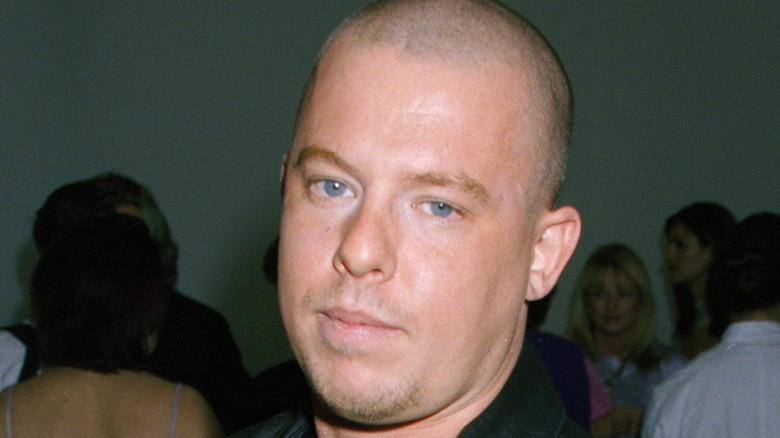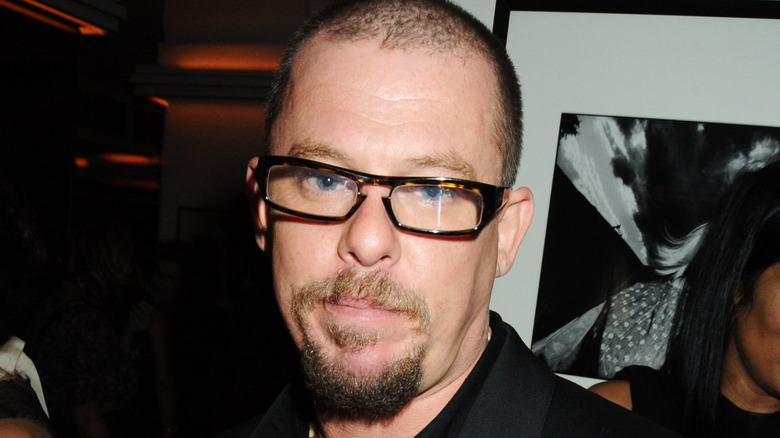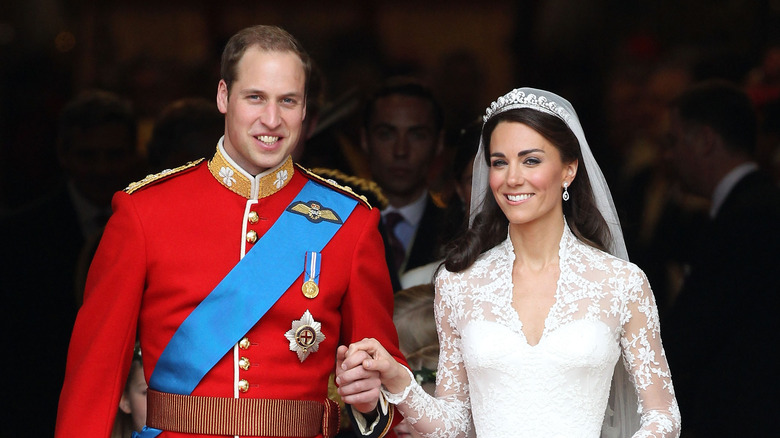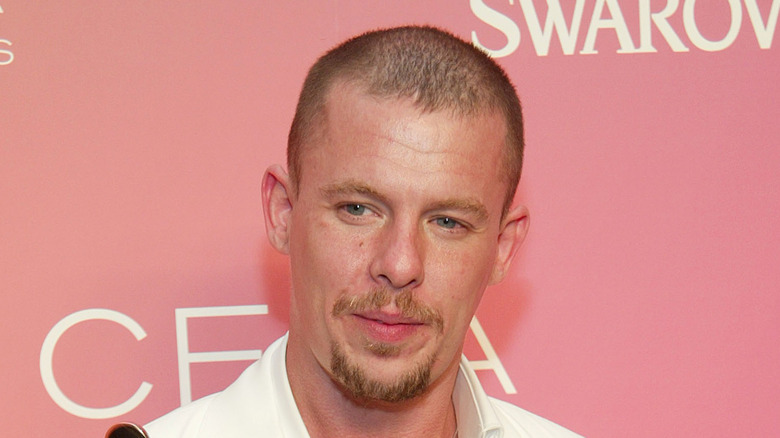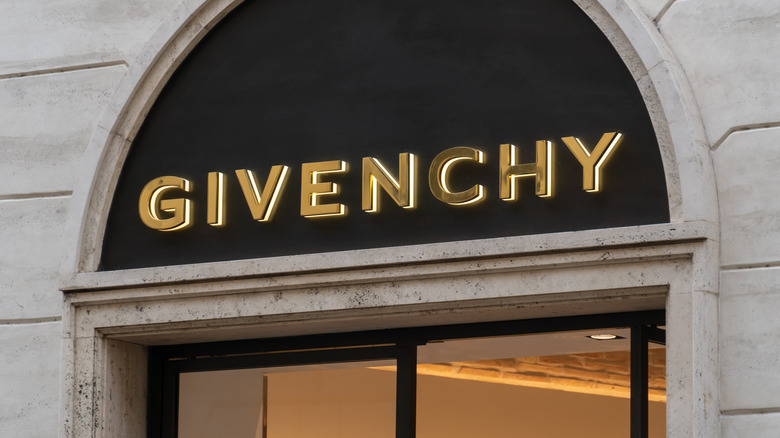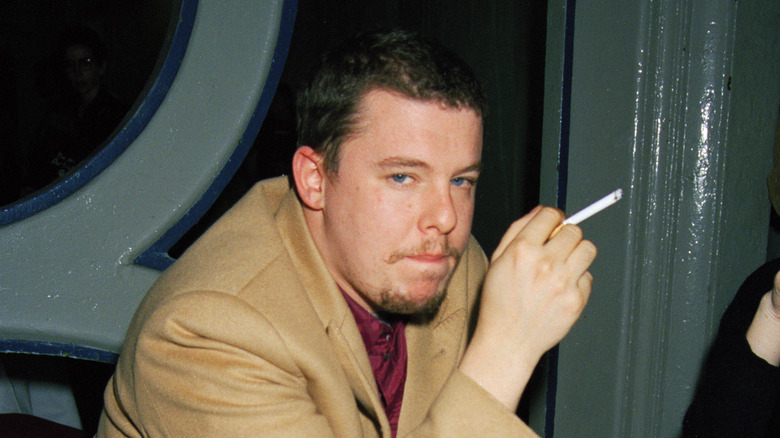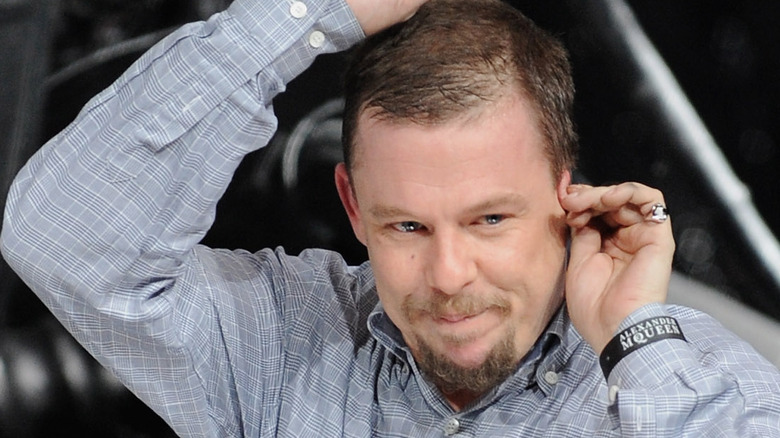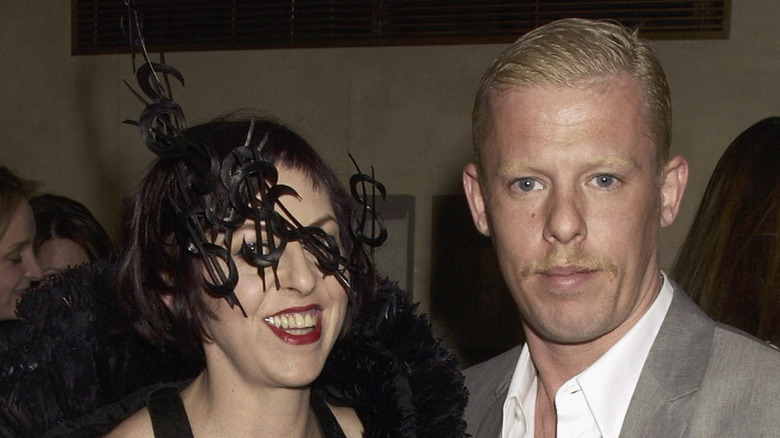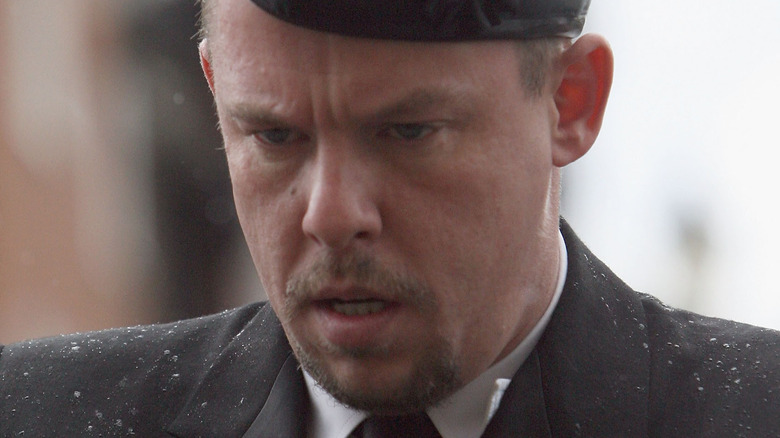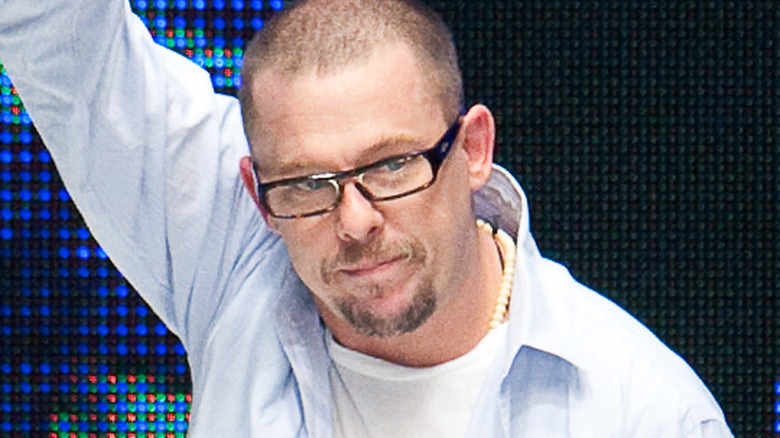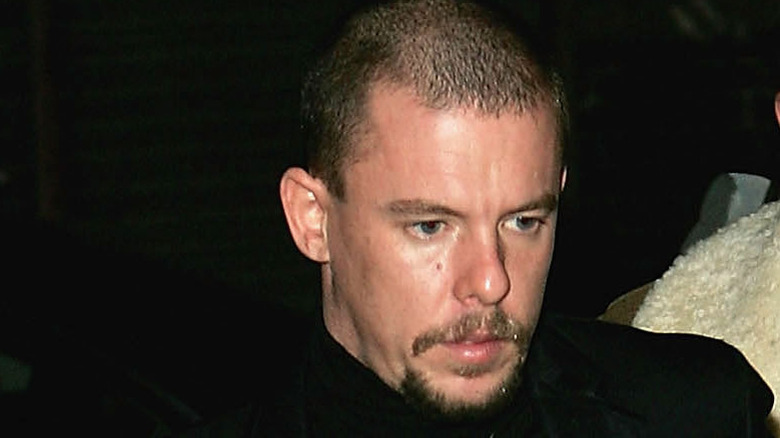The Tragic Real-Life Story Of Alexander McQueen
If one had met Alexander McQueen through a random encounter on the street, few could imagine they caught a glimpse of the fashion genius of the moment. With his look more resembling one of the local Chelsea football fans over a haute couture guru, he fit into the gleaming world of luxury just as cinema "Billy Elliot" fit to the London Royal Opera House stage — not at all. Yet Alexander McQueen, a son of a taxi driver from the suburbs of East London, dreamed of clothes from a young age.
He drew the inspiration for his fashion collections (he created as many as 30 between 2007 and 2010) from his surroundings, without censorship, which would remove what was considered a taboo. From war, assault, mental issues, fetishism, and melancholic nature that would fascinate even Edgar Allan Poe, McQueen created theatrical masterpieces that aroused genuine emotions — sometimes disgust, other times the pure stirring of a soul, moved by the astonishing beauty he was able to create. His clothes were often a wearable narrative. However, his own story often overshadowed his genius. Here is the tragic real-life story of Alexander McQueen.
Grim early years
According to Biography, Alexander McQueen grew up in a big East London household of six kids. His father, a taxi driver, and mother, a social sciences teacher, successfully supported their family on a modest income. It was this background that helped Alexander McQueen stay grounded, although according to his family, he was a bit eccentric from the early age (Via Harpers Bazar).
The environment was nothing out of the ordinary, but the real issues were much deeper — Alexander was often teased by his peers for being a homosexual, which left him with scars for life. The biggest wound was revealed after his death, when his sister, Janet McQueen, confirmed he was sexually abused at the age of 9 (via Vogue). The abuser was Janet's then-husband, who assaulted her as well. The powerful clothes designs Alexander created years later were intended to work as an armor, to protect the women against abuse: "I design clothes because I don't want women to look all innocent and naïve. I want a woman to look stronger. I don't like women to be taken advantage of. I don't like men whistling at women in the street. I think they deserve more respect. I like men to keep their distance from women. ... I've seen a woman get nearly beaten to death by her husband. I know what misogyny is. I want people to be afraid of the women I dress" (via Look Online).
He was plagued by anger issues
At the age of 16, Alexander McQueen left school and started his career working as an apprentice in traditional tailoring workshops on Savile Row, according to ICON. However, despite getting his foot in the door of his chosen career, anger issues followed him along all of his career.
Urban legend says — and confirmed by McQueen himself — while working at a tailor, he had sewn a bad word into the inner lining of a jacket made specifically for Prince Charles, as well as other obscenities revolving around his frustrations about the hard work. (Ironically, later on, his brand became the favorite brand of Kate Middleton, even dressing her up for her royal wedding, as per Town & Country).
At some point he insulted Amy Winehouse at a party in 2006, according to Archie Reed, McQeen's former lover (via the Daily Mail). She didn't forgive him even after he sent her his dress as a gift. On the contrary, she burned it on a barbecue and spat on another one in the middle of Selfridges department store.
Further feuds with celebrities included Victoria Beckham and Courtney Love. Reed also dished that McQueen once stated about the former Spice Girl, "What the f*** does she know about fashion? She's a pop star, and she can't even sing." When she appeared in his famous tartans, he cut her off from "freebies. When Love tried to leave his showroom with a pile of his clothes worth £40.000, he promptly billed her. Reed says he was even angry at Kate Moss, his very good friend, when she signed a deal with Topshop company, reports Grazia.
Lee becomes Alexander
According to Vanity Fair, Alexander was his second name, always known as Lee McQueen to his friends. It was only on the advice of fashionista Isabelle Blow that he changed his name to Alexander McQueen. But his look wasn't in line with the unreasonable high fashion standards of the time. The New York Times notes McQueen struggled with his looks most of his life. Becoming known in fashion circles, he felt his appearance needed to match his new, fancy name — fixed teeth, stomach liposuction, plastic surgery under his chin, tanned skin, numerous hairstyles — he had it all.
McQueen often shied way from the public, running away from attention and from the media after his fashion shows, reports the Los Angeles Times. Instead of enjoying his designer glory, he preferred his privacy. While he wanted to fit the narrative of the successful man that he was, his psychological disturbances were pushed more and more to the front, leaving him depressed and full of self-loathing and anxiety, reports the Independent.
Success at a price
In 1996, Alexander McQueen confidently took over the sophisticated Parisian fashion house of Givenchy, as per Vogue. His appointment was not without controversy, with the French classic haute couture label now under the design influence of a British rebel. His gritty, underground London vibe had nothing in common with the elegance of French fashion giants, and the industry found itself in a state of shock.
Journalist Kate Betts reported on his debut collection and show in 1997 that, "Inside, McQueen, wearing sneakers and cargo pants, tells me he has no intention of becoming the Saint Laurent of the '90s. For a 27-year-old, he's got a lot of gumption." According to Numero, the collection was ripped apart by the press, leaving McQueen full of hate and resentment.
Things didn't improve over the years, and when in 2000 McQueen decided to sell 51% of his own brand to the Gucci group, famous rival of Givenchy and its owner LVHM, the dispute finally blew up (via The Guardian). McQueen's final Givenchy show was canceled last minute from Paris fashion week, on the basis that Givenchy wanted a smaller, more intimate setting. There was nothing for McQueen to do than to return to London.
Cocaine is not a dirty word
With money and massive success also comes responsibility. Numerous collections per year, traveling between Paris and London, and living a high-end lonely lifestyle itself led Alexander McQueen to drug addiction. Cocaine, his favorite drug, helped him to focus and keep up the confidence he never had, resulting in McQueen turning into a very different person.
According to 2011 documentary, "McQueen and I," the designer binged on "vitamin substances" to keep up with the workload. According to The Spectator, McQueen was surrounded by "murderous levels of drug-abuse." Former boyfriend Archie Reed spoke of McQueen's habit to The Sun, revealing that designer "he spent £8million on drugs over 20 years." His drug abuse caused him to spiral into paranoia and obsessive behavior.
In 2009, McQueen almost overdosed twice, as per The Seattle Times, also noting his history of self harm and cocaine abuse. "Usually after a show he felt a huge come-down. He felt isolated, it gave him a huge low," said his psychiatrist, Dr. Stephen Pereira, noting that McQueen felt his work was a "double-edged sword."
As reported by friend and fellow fashion designer Sebastian Pons, the fashion world itself could not be the only reason for McQueen's downfall: "I don't blame the fashion system and the pressure for what happened to Lee. He loved and had a huge passion for fashion (via Marie Claire).
If you or anyone you know is struggling with addiction issues, help is available. Visit the Substance Abuse and Mental Health Services Administration website or contact SAMHSA's National Helpline at 1-800-662-HELP (4357).
Being HIV positive
It was no secret Alexander McQueen was homosexual and had multiple lovers, both serious and fleeting. The scars of his childhood abuse never left him, as abuse never does. His low self-esteem, despite his enormous talent, led him to places no one should visit. A regular partier, as detailed by Vanity Fair, he soon became a part of the promiscuous culture, where everything is allowed.
Alexander McQueen biographer Andrew Wilson revealed (via the Daily Mail), that the designer's life of excess included many anonymous encounters and a rather casual attitude towards protection. "He had no responsibility to himself towards the end. I think that he hated himself, sadly," said close friend BillyBoy.
According to W Magazine, Alexander discovered he was HIV positive towards the end of his life. A 2018 documentary, "McQueen," offered some insight, noting that the diagnosis sent him into a "real depression (via Buzzfeed). In the documentary, his nephew, Gary McQueen, speculates that this was a major reason for Alexander to kill himself, remarking it was "always in the back of [his] mind."
Self-destruction and paranoia
Traumas combined with stress often result in serious mental issues, and Alexander McQueen was sadly no exception. His fashion designs were always connected to the dark side of his many unpleasant emotions, and he became the master of converting pain into beauty. Displaying his anxiety and paranoia in his spring/summer 2001 collection, the audience was faced with models trapped in a mental institution, losing themselves in the halls of madness (via Vogue).
Many of his partners and closest friends mentioned he suffered from depression, anxiety, paranoia, and bipolar disorder. Alice Smith, his publicist and friend, noted, "He was extremely vivacious sometimes, and others he could hardly speak" (via Vanity Fair). According to his friends, there were three sides to McQueen: "The shy, sober, unhappy boy; the funny jokey genius; and the drunk, drugged, nasty suicidal man," as per the Irish Examiner.
Former boyfriend Archie Reed detailed to The Sun various manic episodes, from McQueen misplacing cars to spying on Reed for two days to buying a house he believed were on ley lines.
"I oscillate between life and death, happiness and sadness, good and evil," McQueen once said (via the Huffington Post).
If you or someone you know is struggling with mental health, please contact the Crisis Text Line by texting HOME to 741741, call the National Alliance on Mental Illness helpline at 1-800-950-NAMI (6264), or visit the National Institute of Mental Health website.
The friendship with Isabella Blow
Isabella Blow once remarked there were always two people in the audience of Alexander McQueen's shows — his mother and her (via Vogue). Blow, the rich British fashionista, loved McQueen's work from the very first moment he presented his first full collection. According to Vanity Fair, she introduced him to many important people in the industry, opening him up to the aristocratic world of country houses and expansive accessories. But their relationship was more of a friendship than a business connection, bonding over their love for clothes and dislike of people. However, their relationship was doomed from the start, as both battled bipolar disorder, depression, and other mental health issues.
The two had a falling out after McQueen took the position at Givenchy. With their bond crumbling, McQueen distanced himself from Blow, ultimately losing one of the few friends he had. In the words of designer Julien Macdonald, "Lee wasn't the nicest person to her, but she loved his genius. He was so crazy" (via Vanity Fair).
Blow died by suicide in 2007, after being diagnosed with ovarian cancer. McQueen never commented publicly on her death, according to New York Magazine, but images from her funeral reveal a broken man. McQueen commemorated Blow in his Spring/Summer 2008 collection, La Dame Bleue, creating headpieces full of feathers, birds, and even butterflies (via Victoria & Albert Museum).
Losing his mother to cancer
Alexander McQueen had a very close relationship with his mother, being a proud mama's boy. Joyce McQueen had Alexander's back, and while his father had a bit more traditional views on what means to be a man — he wanted his son to become a plumber (via the New York Times) — his mother was always there to support him. Even when he was only 4 years old, he already had a sense of fashion. As detailed by biographer Andrew Wilson in the Irish Examiner, McQueen refused to wear the jacket and trousers his mother chose for him for a trip to the local park, saying "Mum, I can't wear this. It doesn't go."
She was the first person who always motivated him to become a fashion designer and encouraged his creativity at an early age. His mother was there every time he had a fashion show, bringing homemade sausage rolls, feeding the models and the staff, as per The Times.
In a 2004 interview with The Guardian, McQueen even mentioned his biggest fear was to die before her. Her death, after losing her battle with cancer, broke her son's heart. He took his own life on the evening before her funeral (via the Independent).
The end of the cycle
Alexander McQueen died by suicide on February 11, 2010, leaving a note in his apartment. The dogs were the only creatures that kept him company in the lonely hours leading to his death, besides piles of cocaine and sleeping pills (via Vanity Fair).
Despite the event shocking the world, the tragedy wasn't completely surprising. Many people believe McQueen bid many farewells in the months leading to his premature death, including him claiming to his friend Sebastian Pons in 2009 that he was designing his last collection, according to McQueen biographer Andrew Wilson (via Daily Mail).
Dr. Stephen Pereira, McQueen's psychiatrist, stated that his mother's death was what pushed him over the edge at the end: "He had been terribly let down in long-standing close relationships. He was very close to his mother. I think on top of the grief he felt there was that one link that had gone from his life and there was very little to live for" (via The Guardian).
McQueen once commented on the everlasting nature of life: "It is important to look at death because it is a part of life. It is a sad thing, melancholy but romantic at the same time. It is the end of a cycle — everything has to end. The cycle of life is positive because it gives room for new things."
If you or anyone you know is having suicidal thoughts, please call the National Suicide Prevention Lifeline at 1-800-273-TALK (8255).
Alexander McQueen's family suffered
Alexander McQueen was loved by many, but his legacy was not just the legendary design, but lots of pain as well. His sister, Janet McQueen, told the Daily Mail in 2013 that the family was shut out by the trustees of McQueen's estate following his death. With his name now a bought-and-sold brand, the family had no legal rights — even access to his remaining belongings proved difficult. According to Janet, Alexander would have been appalled at his family's treatment.
Even McQueen's funeral was less a family affair and more a see-and-be-seen gathering of more than 2,500 guests, including models and celebrities. Janet said that the planning of the services was taken out of the family's hands.
"We feel we have been treated like second-class citizens. They didn't let us see his house before it was dismantled or pack up my brother's personal things, which is an essential part of the grieving process, and they are not keeping us informed about his legacy," Janet McQueen said.
